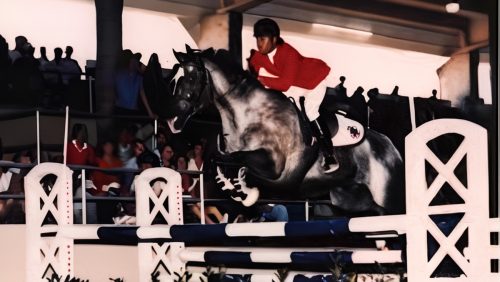Stand beside the finish line of any racetrack in the world and dare yourself to remain unflapped. I’ve tried; it’s futile. The pack rounds the turn, and involuntarily your pulse quickens, eyes darting from hooves to outstretched necks to flying manes and tails as the hijinks of the bettors beside you intensify, the final moments igniting in a blaze of speed so fast it almost takes your breath away. You ask yourself: horsepower? Have I just felt the physical effects?
U.S. Equestrian Federation Technical Advisor and Between Rounds columnist Anne Gribbons recently compared her passion for dressage to her husband’s classic car fascination, and it got me wondering about the definition of a term I’ve always found mystifying.
Horsepower.
Riders know a racetrack isn’t necessary for the experience. Swing into any saddle, anywhere, and there you are: A captain at the helm—and mercy—of galloping, volatile, impregnable horsepower.
And yet horses under car hoods have always seemed an abstract, incongruous concept. Just how does a stampede translate to cylindrical explosions, firing pistons? Where do you draw the line from harnessed power to mechanical speed?
London Breweries
Anyone who’s visited London’s Hyde Park knows that horses are an essential part of the city’s history. Fabled Rotten Row, established as a carriageway along the park’s south side in the 17th century, is maintained today as a bridleway and used daily by the Household Cavalry and Hyde Park Stables to exercise horses.
But anyone who’s seen the tired eyes and too-long toes of overworked carriage horses knows that city life isn’t always so glamorous.
In 1750, Samuel Whitbread, forefather of the U.K.-based Whitbread hospitality company, built up a booming enterprise: A porter, strong and dark, brewed at his “Goat Brewhouse” had gained such popularity that he’d been forced to relocate to larger headquarters in Chiswell Street, where he established the first mass-production brewery in England.
ADVERTISEMENT
The driving force behind breakneck production at Whitbread’s brewery?
Horsepower.
With porter in demand, horses had succeeded wind, water and oxen as the most effective, highest-yielding power source for Whitbread’s brewery mill, the product of which was the porter’s key ingredient: malt powder.
At the Chiswell Street headquarters, six horses were harnessed to spokes radiating from a central mill shaft and prodded to walk the ceaseless circles that powered the grindstones and reduced malt to its powdered state. Large London breweries like Whitbread’s are estimated to have employed an average of 20 horses for the mill at once, cheaply acquired and cheaply cared for, with even the aged, blind and infirm expected to earn their keep.
Watt’s Initiative
Day in and day out, mill horses circled the shaft, revolving approximately 144 times per hour (2.4 times per minute) if you were to believe the observations of one James Watt, an onlooker of dubious intent.
For Watt, like Whitbread, had a booming enterprise: He’d adapted and marketed a steam engine used to pump water from underground mines and was currently scouting the territory for his latest adaptation—a “rotative” steam engine that he believed could outpace horses as the power source for brewery mills.
The hitch? Marketing. Whitbread and his contemporaries had a good thing going with their cheap and laborious workhorses, but Watt knew he had the means to drastically improve production rates. How could he bring them to his side?
An idea struck him. If he couldn’t convince them outright, he’d have to put the steam engine’s specifications into a context that the brewers understood. Watt had already determined that the horses lapped the mill’s 24-foot diameter circle 144 times per hour. For reasons less clear, he estimated that the horses pushed the shafts with a force of 180 pounds. Using a complicated mathematical equation, Watt deduced that a mill horse could push 32,572 pounds one foot in a minute, which he rounded up to an even 33,000 pounds.
ADVERTISEMENT
33,000 pounds pushed one foot in a minute. The power of one horse. One horsepower! Watt, whose name is synonymous with the unit of power you’ll find on your light bulbs—named after him due to his contributions to steam power—had derived a unit of measurement that would stand the test of time. To this day, horsepower is used to describe the output of cars, lawn mowers and even household vacuum cleaners.
Steam Revolution
For Whitbread’s purposes, Watt boasted that one of his steam engines could harness the power of 200 horses at once. 200 horses in a single unit, without so much as a stable to house them? Whitbread was sold, and within a year, production had nearly doubled from 90,000 to 143,000 barrels of brew.
Mill horses were kept on briefly should the machines falter, but soon enough Whitbread and his contemporaries had dispensed their teams in favor of Watt’s industrious engines. London’s breweries had never produced more beer.
In fact, the dispensed mill horses were only a harbinger of what was to come, for the fates of horses and steam power have since been invariably intertwined. Can you imagine, 100 years later, a team of those long-toed carriage horses drinking lazily from a sidewalk trough, blissfully unaware of what was coming around the corner for them? Imagine their eyes at first sight of that jolting, popping, exploding automobile, technology at its most advanced, as it rolled fitfully down the avenue to change their lives—and the future.
And under the hood?
You guessed it.
Horsepower.
As a youngster, Chronicle of the Horse staffer Abby Gibbon was mystified by a black-and-white photo of her grandfather competing in a jumper class in the 1960s. He wasn’t wearing a helmet! His saddle pad was non-existent! The wall he was jumping looked like it would knock you down, too, if you happened to knock it! In the past 50 years, the world of equestrianism has evolved, but one thing is still for certain: History is something we all share as horse enthusiasts, and we’ve got to explore it to learn from it. Armed with nearly 75 years of Chronicle archives, Abby plans to unearth articles we haven’t examined for too many years, shedding light on how far we’ve come – and how far we still have to go – as modern horsemen.
Have ideas for historical topics? Questions or curiosities? Please e-mail Abby – she’d love to hear from you!














